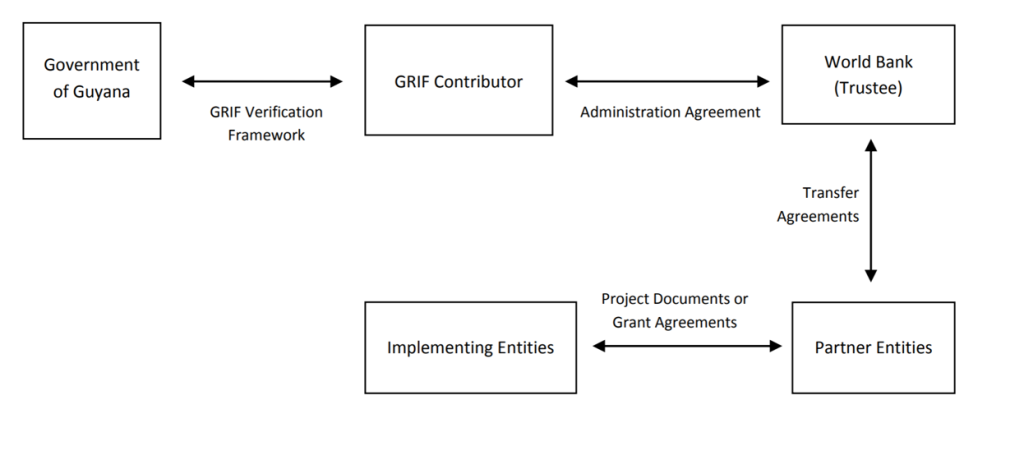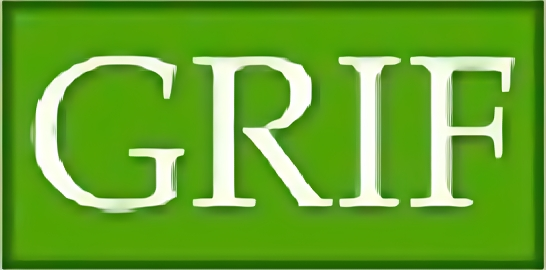The Guyana-Norway Partnership
The Guyana-Norway Partnership is a landmark collaboration aimed at addressing climate change through sustainable forest management and conservation. This partnership began in 2009 with the signing of a Memorandum of Understanding (MOU) between the two nations, under which Norway committed up to US$250 million in result-based payments to support Guyana’s Reducing Emissions from Deforestation and Forest Degradation (REDD+) activities.
What is the GRIF?
To facilitate the management and allocation of funds from Norway, the Guyana REDD+ Investment Fund (GRIF) was established in 2010. The GRIF, a multi-contributor trust fund, serves as a crucial component of the Guyana-Norway Partnership, channeling financial resources towards enhancing REDD+ efforts and promoting low-carbon development in Guyana. Contributions to the GRIF are based on independent verification of performance results measured against the indicators set out in the Joint Concept Note, which includes monitoring Guyana’s deforestation and forest degradation rates. These rates refer to the extent and speed at which forest areas are being cleared or degraded, a critical factor in assessing environmental impact and climate change mitigation efforts.
By 2015, the fund received up to US$250 million from Norway in performance-based payments. REDD+ enabling activities encompass a range of initiatives aimed at reducing emissions from deforestation and forest degradation. These activities include sustainable forest management practices, enhancing carbon stock through reforestation, and supporting community-based conservation efforts. Over the years, the partnership has evolved, and in May 2021, both countries enlisted the Global Green Growth Institute (GGGI) to provide management support for Norway’s roles in the GRIF Secretariat, ensuring effective oversight and communication strategies.
Background on Low Carbon Development Strategy
Guyana’s Low Carbon Development Strategy (LCDS) 2030 aims to combat climate change while simultaneously promoting economic growth and development. It outlines how Guyana’s economy can further embrace a low carbon development path by investing payments received for avoided deforestation into strategic low carbon sectors. These investments will catalyze Guyana’s efforts to diversify its economy, create new economic opportunities and employment, and use resources more efficiently, all while maintaining its valuable forest ecosystem.
The LCDS 2030 outlines four interconnected objectives for Guyana:
- Value Ecosystem Services
- Invest in Clean Energy and Stimulate Low Carbon Growth
- Protect Against Climate Change and Biodiversity Loss
- Align with Global Climate and Biodiversity Goals
Objectives of the GRIF
The Guyana REDD-plus Investment Fund (GRIF) is a multi-contributor trust fund established to:
- manage payments provided by Contributors to the GRIF for forest climate services provided by Guyana
- transfer these payments and any investment income earned on these payments, net of any administrative costs of the Secretariat and the Trustee, to Partner Entities for Projects and activities that support the implementation of Guyana’s Low Carbon Development Strategy (LCDS), and, additionally,
- the GRIF aims to support global efforts in developing a UNFCCC REDD-plus mechanism by serving as a model for REDD-plus payments and ensuring adherence to internationally accepted fiduciary, social, and environmental standards.
Governance Structure of the GRIF
GRIF Agreement structure

GRIF CONTRIBUTOR
Any party that enters into an Administration Agreement with the Trustee to contribute funds to the GRIF.
IMPLEMENTING ENTITY
The Government of Guyana or any instrumentalities thereof or any other entity that is eligible to receive funding in accordance with the Partner Entity’s policies, guidelines and procedures and which the Government of Guyana has agreed to be a recipient of resources.
PARTNER ENTITY
The Inter-American Development Bank (“IADB”), the International Development Association (“IDA”), and any fund, program or specialized agency of the United Nations that is a member of the United Nations Development Group.
The GRIF structure includes Contributors, a Steering Committee, a Secretariat, Trustee, Partner Entities, and various Implementing Entities. See the GRIF Governance Frame
The GRIF will have:
A Steering Committee (SC) serves as the oversight and decision-making body. The Government of Guyana will chair the SC and its members will be the Government and the financial contributors to the GRIF. The Trustee, each of the GRIF partner entities, civil society organizations, and private sector entities will be invited by the SC to participate as observers.
A Trustee: The World Bank’s International Development Association (IDA) was invited by Guyana and Norway to act as Trustee and will be responsible for providing financial intermediary services to the GRIF. The Trustee received funds from Norway and managed them within a trust fund on Guyana’s behalf. The Trustee will make transfers of GRIF resources in the amounts approved by the SC to Partner Entities.
Partner Entities: Partner Entities will provide operational services for the approved LCDS projects. Each GRIF Partner Entity will ensure:
I. consistency with the LCDS and the applicable decisions of the SC, including the purpose for which the funding has been provided.
II. that the Partner Entity’s fiduciary safeguards and operational policies and procedures are followed; and
III. that a robust results framework, as defined by the SC and the Partner Entity, is developed, and agreed upon at the project level.
The Inter-American Development Bank (IDB), the World Bank, and any program or specialized agency of the United Nations that is a member of the UN Development Group are eligible to serve as a Partner Entity. Others may be added if they are approved by the SC as meeting internationally recognized standards for operational policies and procedures as well as fiduciary, safeguard, and operational standards.
Implementing Entities: Partner Entities will enter into agreements with Implementing Entities, which will receive funds from the Partner Entities and be responsible for the implementation of the relevant project or activity. These may include the Government of Guyana or any other entity that is eligible for funding in accordance with the relevant policies, guidelines, and procedures of the Partner Entity and approved by the SC.
A Secretariat of the GRIF has been established. The Governments of Norway and Guyana will constitute the secretariat and provide necessary administrative support to the Steering Committee for the operation of the GRIF.
The Value of Projects by LCDs Thematic Area
Norway is the only contributor to the GRIF. The Governance Framework of the GRIF is designed with the necessary flexibility to allow other contributors to participate.
The Joint Concept Note between Guyana and the Norway sets out how Guyana is establishing a Monitoring, Reporting and Verification (MRV) system for emission or removals of carbon from Guyana’s forest sector. As this evolves several basic interim indicators will be used to assess Guyana’s performance. The payment will be based on an independent verification of Guyana’s implementation of REDD+ enabling activities.
The Low Carbon Development Strategy until 2030 (LCDS 2030) was developed following a seven-month national consultation on an initial draft. It outlines how Guyana can adhere to the vision established in 2009 by creating a model that avoids deforestation and preserves forests, while simultaneously increasing the economy five-fold over ten years and maintaining stable energy emissions. The strategy includes investments in urban, rural, and Amerindian development, coastal and hinterland climate change protection, job creation in low-carbon sectors, alignment of education and health sectors with low-carbon development, and economic integration with neighboring countries.
The LCDS 2030 defines four interlinked objectives for Guyana. The first three have been core objectives since 2009, and the fourth was added to address new local and global challenges:
- Value Ecosystem Services
- Invest in Clean Energy and Stimulate Low Carbon Growth
- Protect Against Climate Change and Biodiversity Loss
- Align with Global Climate and Biodiversity Goals.
Application of safeguards to the activities and projects financed by the GRIF
The following safeguards were identified to ensure that REDDplus contributes to the achievement of the goals of the partnership:
Strategic Framework: Guyana’s REDD-plus efforts, including forest conservation and sustainable management, are developed under an internationally recognized framework and integrated into the LCDS 2030. All financial contributions and expenditures will be transparently managed and publicly disclosed.
Continuous Multi-Stakeholder Consultation Process: The REDD-plus strategy and LCDS funding needs will undergo a transparent, multi-stakeholder consultation process, ensuring the participation of all affected parties, especially indigenous communities. This process will be monitored by an expert team, providing regular reports and advice.
Governance: Guyana’s forest governance will be based on independent assessments and relevant legislation, aiming for a transparent, rules-based system. A detailed REDD-plus governance development plan will be created, reviewed by an independent institution, and updated annually.
MRV: A national system to monitor, report, and verify carbon emissions or removals in Guyana’s forest sector will be developed according to IPCC guidelines. This system will include a roadmap with timelines and costs, and Guyana will publish annual reports on its implementation.
Rights of Indigenous Peoples and Local Communities: The rights of indigenous peoples and local communities to participate in decision-making will be respected and protected throughout Guyana’s REDD-plus and LCDS initiatives, ensuring their effective involvement in planning and implementation.
Annual Assessment & Verification: Annual independent assessments will be conducted to evaluate whether REDD-plus objectives are met and to review Guyana’s performance. A neutral expert organization will provide status reports and recommendations for improvements.
Projects funded by the GRIF
Project title | Status | Project approved year | Partner Entity | Total Cost (USD) | |
1 | IS – Institutional Strengthening LCDS – IDB | Completed | 2011 | IDB | 6,250,000 |
2 | IS – Institutional Strengthening LCDS – CI | Completed | 2011 | IDB | 1,060,000 |
3 | EU-FLEGT support – CI | Completed | 2011 | DFID | 1,700,000 |
4 | MRV Phase 1 – CI | Completed | 2011 | CI | 4,905,499 |
5 | ADF 1-2- Amerindian Development Fund | Completed | 2012 | UNDP | 8,143,042 |
6 | MSE – Micro and Small Enterprise Development | Completed | 2012 | IDB | 5,127,476 |
7 | ALT – Amerindian Land Titling Project | Ongoing | 2013 | UNDP | 13,226,370 |
8 | CRSAP – Climate Resilience Strategy and Action Plan – CI | Completed | 2014 | CI | 343,297 |
9 | LCDS Outreach Program – CI | Completed | 2014 | CI | 157,412 |
10 | CC – Cunha Canal Rehabilitation Project | Completed | 2016 | WB | 3,373,000 |
11 | GSDS – Green State Development Strategy | Completed | 2017 | UNEP | 1,500,000 |
12 | MRV Phase 2 – CI | Completed | 2017 | CI | 6,340,000 |
13 | ICT Hubs for Hinterland Remote and Poor Communities | Ongoing | 2017 | UNDP | 17,030,752 |
14 | SLDM – Sustainable Land Development and Management | Ongoing | 2018 | FAO | 14,792,277 |
15 | MRV Phase 3 – CI | Ongoing | 2021 | CI | 8,141,574 |
16 | GUYSOL – 33MWp Solar farms | Ongoing | 2022 | IDB | 83,300,000 |
17 | GUYSOL – Technical Cooperation | Ongoing | 2022 | IDB | 1,500,000 |
18 | Village Sustainable Plans | Planned | 2023 | CI | 3,400,000 |
19 | Coastal Adaptation and Resilience Project | Planned | 2024 | WB | 46,000,000 |
- Monitoring, Reporting and Verification Project, Phases 1 to 3
- Amerindian Development Fund – Village Economy Development
- Institutional Strengthening Program in Support of Guyana’s Low Carbon Development Strategy (LCDS)
- Amerindian Land Titling Project
- Cunha Canal Rehabilitation Project
- ICT for Hinterland, Poor and Remote Communities Project
- Mainstreaming Sustainable Land Development and Management
- Knowledge and Capacity Development for Inclusive Green Development Transition in Guyana
- Micro and Small Enterprise (MSE) Development and Building Alternative Livelihoods for Vulnerable Groups
- Guyana Utility Scale Solar Photovoltaic Program
